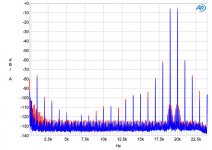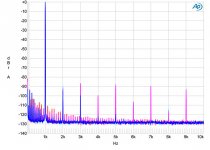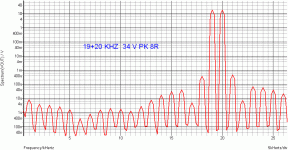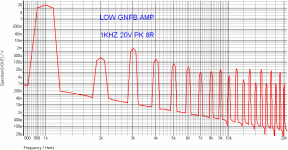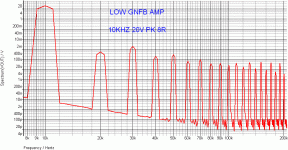Hi,
I only heard the Soulution Amp in the system of a reviewer, who, it may be fair to say did not particulary like the results he got from an AMR CD-Player in his system (which is rather rare, he is pretty much the only reviewer so far to react like this). Note I cannot talk about the Amp (or anything else) in isolation, only the whole system, speakers, room, room setup, sources, cables and all.
While I did not find the system sounded offensive or anything objectionable, I have to say that enjoyed the small middle eastern restaurant we visited later by far more (their Houmus was superb) than listening to music through this system, it just did not particularly make me want to listen to music. Yet he clearly enjoyed his system, so all the better for him.
De gustibus non disputandum est.
Maybe the Amp was perfect but the music was wrong?
To add a further data-point, I have had many repeat occasions where I heard Kondo/Audio Note Japan SE Amplifiers (Baransu, Kegon, Ongaku, Gaku-On and others) with reasonably sympathetic speakers (this included an Ongaku with Wilson Watt/Puppy Speakers FWIW) and enjoyed the results immensely, as did many others on many occasions.
Next to any of these amplifiers at rated power the measurements you show would be good. A representative sample of what these amplifiers would more or like measure in the pages of Stereophile can be found with the Audio Note (UK) Jinro:
Audio Note Jinro integrated amplifier Measurements | Stereophile.com
Again, I do not claim that all SE Tube measure precisely like this or that it measures precisely like Kondo, only that these measurements are quite representative of a nominal 20W SE Tube Amp.
Yet such relatively poor measurements did not seem to make those amplifiers sound bad, on the contrary. To add more, whenever I encounter Kondo gear at shows, it was always in rooms that got considered y many visitors to offer "good sound"and routinely where packed non stop, with many visitors sitting down and listening for very long periods of time, often sitting quite still (I can tell from my photo's taken). I find this in contrast to many rooms where people tend to walk in and possibly sit down only to get up and walk out again quickly.
Perhaps also telling is how JA chooses to close his measurements section for the ANUK Jinro:
Ciao T
This is what i'm trying to get a grasp on, what is good, what is bad , what is absolute ..? I mean the soulution amplifiers measured immensily low ..... sonics..?
I only heard the Soulution Amp in the system of a reviewer, who, it may be fair to say did not particulary like the results he got from an AMR CD-Player in his system (which is rather rare, he is pretty much the only reviewer so far to react like this). Note I cannot talk about the Amp (or anything else) in isolation, only the whole system, speakers, room, room setup, sources, cables and all.
While I did not find the system sounded offensive or anything objectionable, I have to say that enjoyed the small middle eastern restaurant we visited later by far more (their Houmus was superb) than listening to music through this system, it just did not particularly make me want to listen to music. Yet he clearly enjoyed his system, so all the better for him.
De gustibus non disputandum est.
Maybe the Amp was perfect but the music was wrong?
To add a further data-point, I have had many repeat occasions where I heard Kondo/Audio Note Japan SE Amplifiers (Baransu, Kegon, Ongaku, Gaku-On and others) with reasonably sympathetic speakers (this included an Ongaku with Wilson Watt/Puppy Speakers FWIW) and enjoyed the results immensely, as did many others on many occasions.
Next to any of these amplifiers at rated power the measurements you show would be good. A representative sample of what these amplifiers would more or like measure in the pages of Stereophile can be found with the Audio Note (UK) Jinro:
Audio Note Jinro integrated amplifier Measurements | Stereophile.com
Again, I do not claim that all SE Tube measure precisely like this or that it measures precisely like Kondo, only that these measurements are quite representative of a nominal 20W SE Tube Amp.
Yet such relatively poor measurements did not seem to make those amplifiers sound bad, on the contrary. To add more, whenever I encounter Kondo gear at shows, it was always in rooms that got considered y many visitors to offer "good sound"and routinely where packed non stop, with many visitors sitting down and listening for very long periods of time, often sitting quite still (I can tell from my photo's taken). I find this in contrast to many rooms where people tend to walk in and possibly sit down only to get up and walk out again quickly.
Perhaps also telling is how JA chooses to close his measurements section for the ANUK Jinro:
Stereophile said:As Art Dudley asked in his conclusion, "Do single-ended amplifiers sound wonderful because they're uniquely true to the music, or do they sound wonderful because they falsify and misshape the music, however appealingly?" I wish I had an answer to that question.—John Atkinson
Ciao T
Show me graphs of the same amp, but for 150W on 8 Ohm, and 300W on 4 Ohm. Also, for 1 and 10 W, so I may suggest you something useful.
Those previous graphs are of the same amp , this one is of another ....difficult to get exactly what you ask ...
Attachments
a.wayne, there is NOT enough info to tell anything about the actual distortion at 1W. This is a critical flaw in this measurement combination. We are not fooling! Look at the THD curve with power. How much is distortion and how much is noise? That would depend on how hot the amp ran into Class A. Do you know?
Last edited:
Couldn't find anything at 1 W , 10 w as below ....compare to post 1282
"Fig.10 Plinius SA-103, spectrum of 1kHz sinewave, DC–10kHz, at 10W into 8 ohms with class-A/B bias (left cyan, right magenta) and class-A bias (left blue, right red). (Linear frequency scale.)"
http://www.stereophile.com/content/plinius-audio-sa-103-power-amplifier-measurements
"Fig.10 Plinius SA-103, spectrum of 1kHz sinewave, DC–10kHz, at 10W into 8 ohms with class-A/B bias (left cyan, right magenta) and class-A bias (left blue, right red). (Linear frequency scale.)"
http://www.stereophile.com/content/plinius-audio-sa-103-power-amplifier-measurements
Attachments
I will check john......I guess JA uses best case when testing , to avoid the obvious ....
I generally run the amplifier into visible waveform clipping on a 'scope with the mix of 19 and 20kHz tones, then back off the level by about 3dB.
Edit: Meant to add that this is done with care at the end of the testing, as with inexpensive amplifiers this can sometimes let loose the magic blue smoke.
John Atkinson
Editor, Stereophile
JA just measured it, incompletely. He did not do anything wrong. However, he did NOT show the distortion at the transition between Class A and Class AB which is usually worst case until you get near that absolute peak output of the amp. The higher order distortion is AWFUL in the Plinius and probably pretty bad in the Soul--- amp. Look at the idle current, which you can derive from the idle power, then measure at the transition, especially at 4 ohms. That is what I do.
I generally run the amplifier into visible waveform clipping on a 'scope with the mix of 19 and 20kHz tones, then back off the level by about 3dB.
Edit: Meant to add that this is done with care at the end of the testing, as with inexpensive amplifiers this can sometimes let loose the magic blue smoke.
John Atkinson
Editor, Stereophile
Thanks for the response JA........
Idle current 2.1 amps ....
That s considerable and allow classe A operation up to 100 W RMS/8R
provided the output stage is an adequately designed push pull.
IMD 1920 products seems quite high unless it is close to clipping zone.
Right. And when I look at such pictures I want to see them in dynamics, otherwise they tell nothing. If it is close to clipping zone, it can be a nice amp.
Then very very close , as if it s done at -3db under clipping it would
be not very good, not to say mediocre....
Still, it depends on topology. Can be mediocre, can be excellent.
Look everyone, no matter HOW you cut it, 200W and 130W per channel into 8 ohms, will NOT give you 2.1A Iq.
First what is the LOWEST +/- supply voltage that you can use single sided? (bridged will give you similar results, but needs different calculations).
Even +/- 50V STIFF, will give you only about 150W into 8 ohms with NO voltage losses, (virtually impossible). But let's say with solid state switching magic, we could actually operate at +/- 50V, and get good performance at 130W, then we could get perhaps 1.8A IF the standing power spec. (200W) is for ONE channel only. You have to leave some power for the other circuitry, besides the output stage.
Then we have a peak Class A current of 3.5A (let's be practical).
This is VERY optimistic. (more later)
First what is the LOWEST +/- supply voltage that you can use single sided? (bridged will give you similar results, but needs different calculations).
Even +/- 50V STIFF, will give you only about 150W into 8 ohms with NO voltage losses, (virtually impossible). But let's say with solid state switching magic, we could actually operate at +/- 50V, and get good performance at 130W, then we could get perhaps 1.8A IF the standing power spec. (200W) is for ONE channel only. You have to leave some power for the other circuitry, besides the output stage.
Then we have a peak Class A current of 3.5A (let's be practical).
This is VERY optimistic. (more later)
Whatever the topology the trend will be the same.
High feedback designs will see increasing THD and IMD with increasing
output level and frequency while some low feedback designs will see
only a slight increase of THD and IMD with rising power but less with rising frequency, not that they are better but they simply start with way higher distorsions at low frequencies and then see a more or less constant( but high in magnitude ) distorsion with frequency, as in the exemple below.
High feedback designs will see increasing THD and IMD with increasing
output level and frequency while some low feedback designs will see
only a slight increase of THD and IMD with rising power but less with rising frequency, not that they are better but they simply start with way higher distorsions at low frequencies and then see a more or less constant( but high in magnitude ) distorsion with frequency, as in the exemple below.
Attachments
- Status
- Not open for further replies.
- Home
- Member Areas
- The Lounge
- Sound Quality Vs. Measurements
